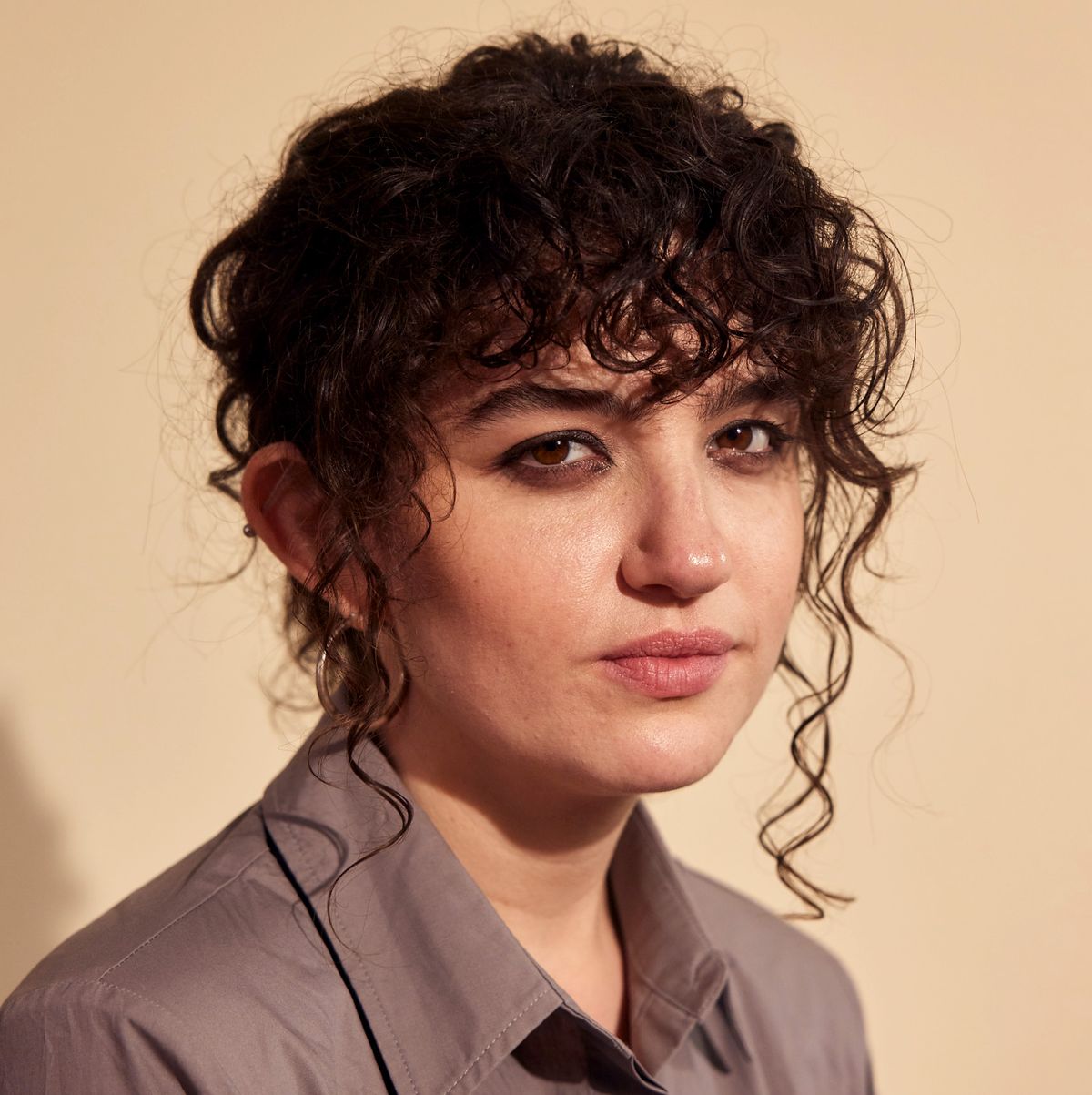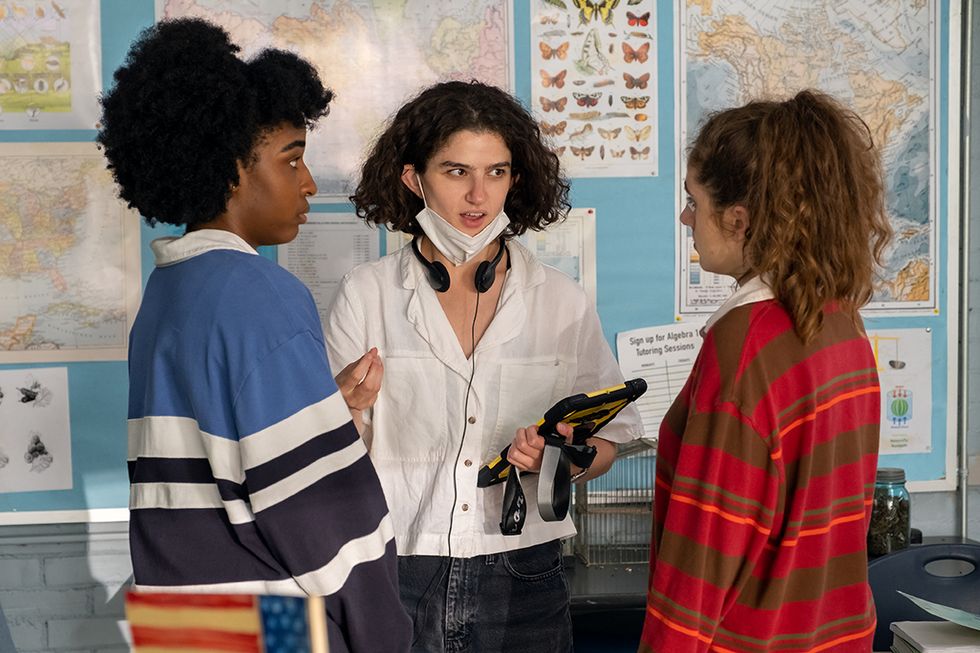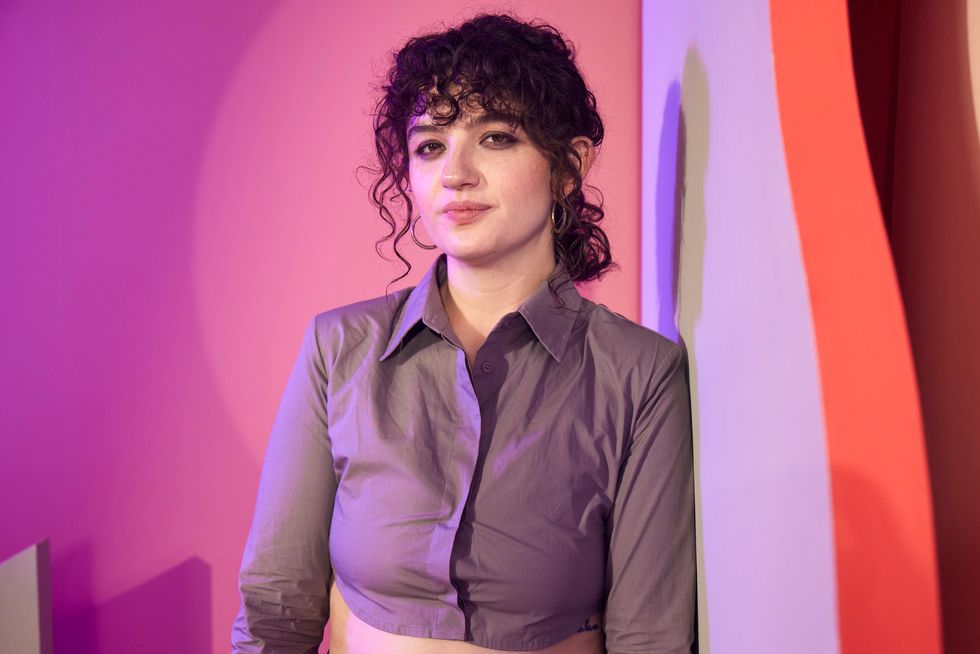It wasn’t until Emma Seligman found themself with a budget for car bombs and mascot penises that the gravity of Bottoms, their sophomore sex comedy, finally set in. Six years prior, the gags had only lived as ideas on the whiteboard of an NYU basement. There, Seligman and their co-writer, Rachel Sennott, mapped out their film school dreams: a multimillion-dollar blockbuster directed by Seligman, starring Sennott and their fellow NYU classmate, Ayo Edebiri. The difference between the trio and most other film school kids imagining similar utopias? They made it happen.
When I talk to Seligman over Zoom, days before Bottoms's August 25 US premiere, it’s clear that the now-28-year-old director—along with Edebiri and Sennott—have treated their craft like it was work long before they were getting paid for it. “I knew Rachel before she posted her ‘It's L.A.’ video, you know?” Seligman says, referencing Sennott’s seminal moment of Internet fame. “Or when Ayo got Big Mouth. These were all such important moments, especially at the beginning of their careers.” With the encouragement of Sennott, Seligman adapted their senior thesis short, Shiva Baby, into a feature—gaining Seligman and Sennott critical acclaim for their directing and acting work, respectively. The performance quickly launched Sennott into roles in HBO's The Idol and A24's Bodies, Bodies, Bodies. Meanwhile, after steadily racking up writing and acting credits on Big Mouth, Abbott Elementary, Dickinson, and more, Edebiri landed an Emmy-nominated breakout role as Sydney in The Bear.
By the time Bottoms finally culminated into a reality, gaining an $11.3 million (around £9 million) budget with MGM, Brownstone, and Orion Pictures, the project marked less of a surreal breakthrough for the trio, and more of a natural progression. “When you're close with someone, you're not really stepping out of the moment and and being like, Whoa, this is crazy, too often,” Seligman explains. “It's like having a sibling or someone you see every day. You're not tracking the changes day to day.”
The elevator pitch for Bottoms isn't that crazy. According to Seligman, at least. "It's a teen sex comedy, but there are queer girls," they offhandedly recite, "And the way that they try to hook up with girls is to start a fight club." From a Charli XCX and Leo Birenberg-composed score, to epic, gory fight sequences, Bottoms feels like one campy, absurd, raunchy payoff for Seligman's years of labor. Below, the director explains how they pulled off this year's best—and bloodiest—comedy.
ESQUIRE: I know you let Rachel and Ayo take the reins when it came to improv—tell me what that looked like.
EMMA SELIGMAN: I got all this advice from other directors who use improv, and they were like, "Make sure you get the shot as scripted first—and then have fun." Or, "If you're going to use improv, be really specific about when, how, and still give direction." But Ayo and Rachel are just such good improvisors—and also felt a certain amount of confidence on set, because we're all so close—that they would just start improvising and my plan was derailed. So, I had to just manage their improvising, if anything. Let them do their thing completely, and just really try to keep in mind what the scene was. Which they were doing, too, but there wasn't that much of a structure. It was very much just trying to navigate their process—as opposed to them navigating mine.
Your cast is full of names that might be surprising at first glance—including Marshawn Lynch and Kaia Gerber—which you’ve said was intentional.
This is such a weird world of characters and we couldn't have anyone just doing the role and being a really good actor. We needed someone to bring their own vibe to it. Also, we looked toward camp casting—and, like, John Waters casting. [We thought] about Cry Baby and having an adult film star with a teen heartthrob, a musician. We wanted question-mark casting. We also just wanted the best people for the roles, and that's just what happened. We wouldn’t have cast people who didn't do the best audition tapes and prove that they were the right person.
Any Marshawn Lynch stories from set?
He was so kind. He was always so supportive. He'd always be like, "How are you doing? How are you feeling?" He was so sweet. He’s just like a big teddy bear. I know a lot of people don't sort of see him that way, but I would. Whenever I would turn the corner, he'd be there. We could be having the most stressful day and he'd be like, "Hey, what's good?" And I'd be like, "It's all good!" [Laughs.] Because you just want to smile in response to his energy.
In March, you told Esquire US that the transition from directing indie films to working on a studio set did came with some growing pains—from handling bigger crews to imposter syndrome. Did you overcome those challenges?
I don't know if I overcame any of them, but I think that you just have to suck it up. I know that sounds really simple and annoyingly macho, but you don't have time to cry about it. You just have to get over it. I knew on this one I wasn't going to be able to overcome it. You just have to fake it till you make it, like everything else. You just can't show it.
Thankfully, every time I talk to someone and I tell them I was feeling panicked or having impostor syndrome, people are like, "Oh, I had no idea." I ran into our costume designer recently and I was reminiscing, thinking that was clear information that I was so panicked. She was like, "You would have never been able to tell." So, I think that you just have to hide it and find your people to confide in. I would often confide in Rachel and our DP, Maria [Rusche] and our producer Alison [Small], and be like, “AHHH!” You have to have your key people that you're allowed to do that with. But otherwise, you got to have a strong face.
I’ve watched Bottoms a few times now, and I'm always finding new throwaway jokes. I actually wrote down a few examples as part of a larger question—and my editor immediately flagged one and was like, “Wait, this has to be a standalone question.” The mascot—
Yeah! [Claps.] I’m so glad you noticed it. Some friends of mine who've seen it a few times still haven't noticed the mascot. The mascot was such a big point of conversation—not in terms of can we have it or not—but that mascot costume was always written into the script. Rachel, just from day one, was like, "The mascot comes out—it's a dog with a giant penis." And we were like, "Ha, ha," and then kept writing along our merrily way.
When we were in prep? Oh. My. God. We would have hours and hours worth of conversations with our production designer, Nate, and our costume designer, Eunice. She had long conversations with the fabricator. There were such long, funny conversations about, like, "And how big do you want the penis to be? Is it a dog penis or a human penis? Is it fuzzy? What about the eyes? Are they glassy? What does his chest look like? What kind of shoes is he wearing?" It was so much fun, and I was like, "I can't believe Rachel took a millisecond to write this joke in a coffee shop five years ago. Now we're here spending hours trying to figure out what this looks like."
I read a bit about your brainstorming process with Rachel, in which you'd throw out ideas that you wanted to fit in somehow—like the bomb. Is there anything that made the final cut that surprised you?
I'm really glad we were able to execute our fight sequences with the detail and gore that we wanted them to have. There is a version of these fight sequences that could have been less choreographed, less sophisticated, and a little sloppier. But we wanted them to feel cool—and I'm glad that we had the strength and support behind us to execute them well. But there was never a point where people were like, "No bomb."
The bomb, the mascot—these were all moments that reminded me of this level I was at. It reminded me of the budget of the movie, where I was like, Oh, no one is like, "You can't have this." Everyone is like, This is written into the script and the director wants it, so we will achieve it.
Something that struck me about Bottoms is its tone. You're killing football players and it doesn't feel like that big of a deal. But the movie still feels grounded.
Tone and discovering and figuring out the rules of the world are the hardest thing to achieve—no matter what movie you're making. And they are constantly evolving. I remember Ayo—because she is so close to us and she knew about the project for so long, but wasn't writing it with us… Once she became more heavily involved, that ended up being a pivotal layer of the process. Because she was able to zoom out and be like, "OK, we can get away with this, but we can't get away with that? What are we trying to do here?” She's such a talented writer. That was a really helpful part of the process, because I trust her, but also because she was playing the lead of the movie. She was able to have a close, yet objective perspective on the script and provide her insight on the rules of the world.
In your filmography, you've focused on telling stories about queer people who are outwardly flawed—or, as Josie and PJ referred to in Bottoms, "ugly, untalented gays."
I don't know any queer people that are perfect. So I only want to tell stories about real people. Even if it's in a ridiculous genre or in a ridiculous world, it's unfair that we have to expect our characters onscreen to uphold a standard that straight people don't need to uphold, or haven't had to for generations.















